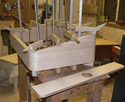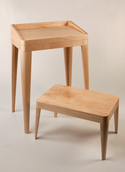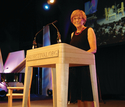US hardwoods make Hay
6 August 2011Designer Lou Christie and designer/maker Andy Dix used American hard maple to create a new lectern and low discussion table for this year’s Hay Festival.
Summary
• AHEC sponsored the discussion featuring Kevin McCloud.
• The new lectern and table were made from American hard maple.
• The lectern will be used at other events run by the Hay Festival organisation.
• An American red oak chair and tulipwood canopy and bench were also at the festival.
During Kevin McCloud’s discussion with Daily Telegraph arts editor Sarah Crompton at this year’s Hay Festival, the television presenter and developer was vocal about his belief we should be making and designing products that last. “The concept of disposable furniture cannot be sustainable and we should be using materials sensibly and wisely and embracing natural materials where we can,” said Mr McCloud.
He highlighted that too little value is put on the craftsmanship and the environmental impact of a product. On stage with him during the discussion, which was sponsored by The American Hardwood Export Council (AHEC), were the maple lectern and low table – two refined pieces that fit in perfectly with Kevin McCloud’s ethos of traditional skills and low carbon design.
Although both items are very simple and easy on the eye, this belies the complexity of their design and construction – the lectern alone comprises more than 60 components. Added to this, they were delivered to a tight deadline of four weeks from concept to finished product.
Lectern design
Using American hard maple supplied through James Latham in Dudley, the lectern design needed to accommodate cables and solve the problem of the variation in heights of different speakers, as well as providing a means of showcasing the qualities of the maple. The main body of the lectern is made from layers of timber with an obvious shadow gap between them to emphasise a ‘stacked effect’. “We used five layers in all,” said designer/maker Andy Dix, “with the height of each layer increasing by 10mm from 20mm at the top to 60mm at the bottom. Each is constructed as a rectangular frame of maple with concave radiused internal corner reinforcement in red oak.”
For the design to work, it was essential that the timber on the external face of each frame ran continuously around the edge, thereby concealing the corner joints of the frame and making it appear as a rectangular hoop. To achieve this a 2.5m-long strip of thin maple was applied to the outside face of each frame and steam bent at the point where it needed to wrap around the corner.
A soft form is given to the top piece of the unit, which feeds into the curve and tapering of the legs. The top piece is segmented into subtle bands of wood, with the legs constructed from two pieces of timber, cut from adjacent positions on a single board so that when they are mitre jointed the grain will appear continuous. Each leg is around 900mm long and tapers from 95x95mm at the top to 40x40mm at the bottom. They have a 45mm radius on them to follow the radius on the corners of the top section and the timber from which they are formed reduces in section along the length, from 30mm at the top to 20mm at the bottom, keeping the proportions looking right as the leg tapers.
Complementary table
Taking references from the lectern, the low table is a complementary piece. Although the design is visually simple, some technical challenges were thrown up by the subtle sloping sides of the top surface, and the requirement for the top to be formed from continuous bands of timber.
“The table surface is made from a sheet of 12mm birch ply, veneered top and bottom with carefully selected and book-matched veneers which we cut in the workshop,” said Mr Dix. “The top is edged with a band of maple which has been steam bent to follow the 45mm radii at each corner of the top. The sides of the top each consist of a rectangular maple frame with 45mm radiused corners, edged with a continuous band of maple. Again, this continuous band is steam bent to follow the radiused corners and neatly butt-jointed at the tear of the table.”
To keep everything tidy for transport, both items have a locating block, complete with thread inserts and 4mm Allen key, for the flat storage of the legs which are easy to detach. The lectern will now travel to the Hay Festival in Segovia, Spain, and other European events run by Hay Festival organisation.
American hardwoods were at the forefront of designer furniture throughout the Hay Festival: the solid American red oak chair, designed and built by Philip Koomen, made its fourth appearance, and the return of the Clare Keil’s Wave and Splash canopy and bench, both made in American tulipwood, also featured again.


